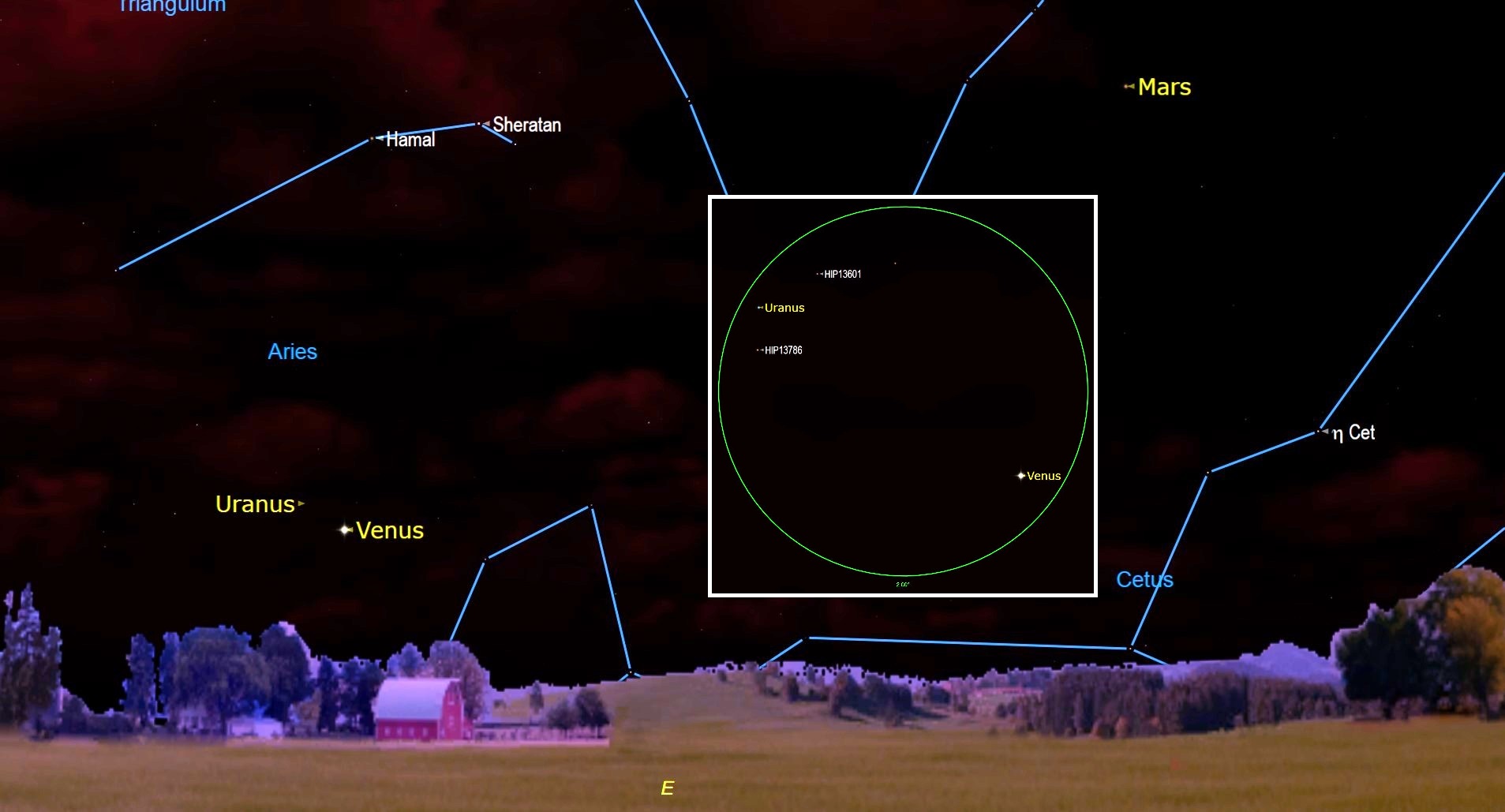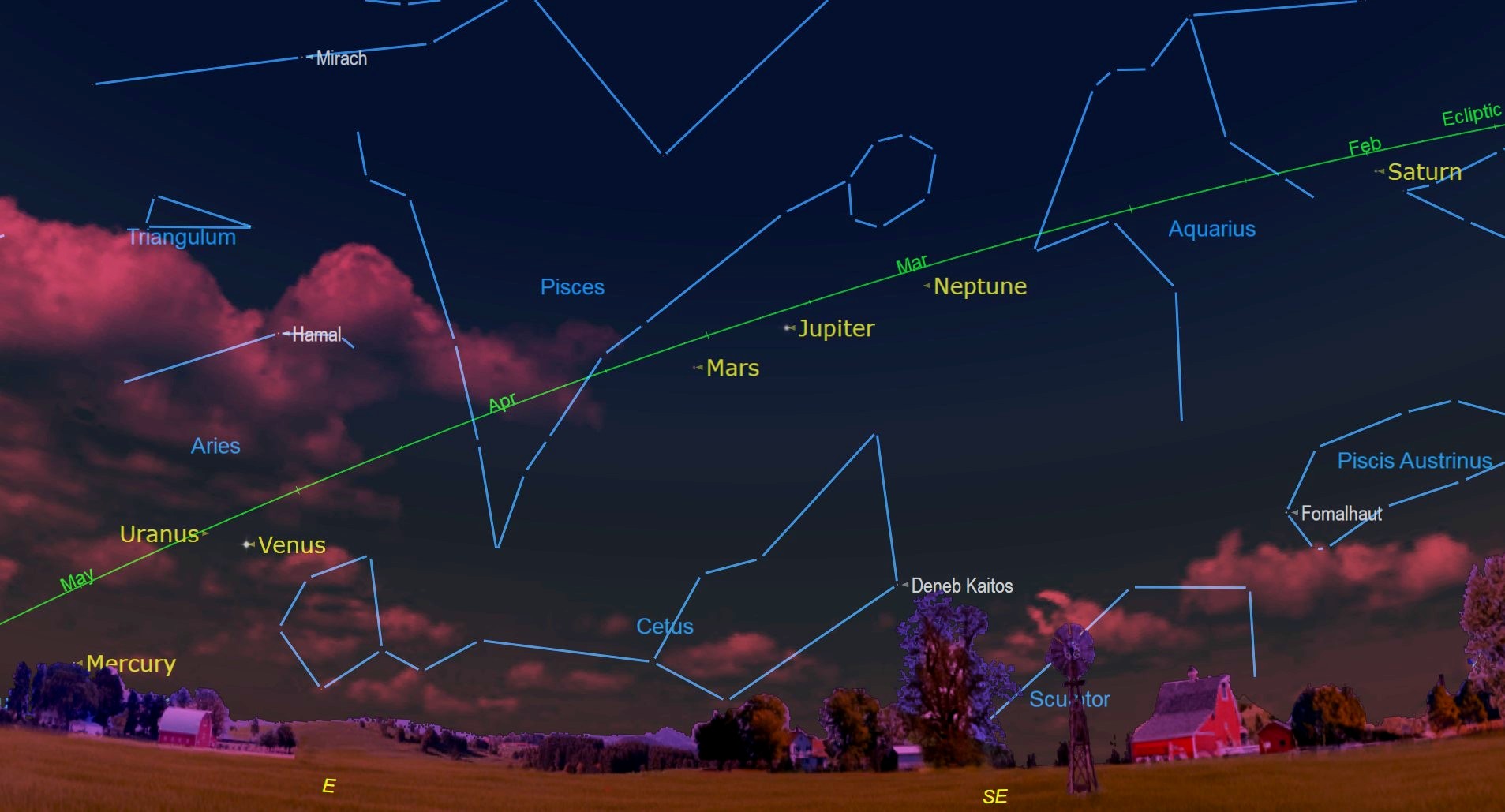Spot Uranus near Venus in the predawn sky on Sunday
You'll need binoculars or a telescope to see Uranus, but Venus is extremely bright in the eastern sky.

The brilliant planet Venus will shine near Uranus before sunrise early Sunday (June 12), acting as a bright signpost for stargazers hoping to spot the more distant (and dim) gas giant in the night sky.
Venus is currently visible in the morning sky before dawn and can be found low in the eastern sky. The planet Uranus is not visible to the unaided eye, but can be spotted with binoculars or a telescope. It can be found to the upper left of Venus.
Uranus is about a thumb's width away from Venus, according to Chris Vaughan, a geophysicist and amateur astronomer with SkySafari Software who oversees Space.com's Night Sky calendar.
Related: The brightest planets in June's night sky and how to see them

Looking for a telescope for the next planet sight or skywatching event? We recommend the Celestron Astro Fi 102 as the top pick in our best beginner's telescope guide.
Early Saturday (June 11), Venus overtook Uranus in the sky and the two planets were actually slightly closer than they will be on Sunday, appearing just 1.7 degrees apart. (Your closed fist held out at arm's length covers about 10 degrees of the night sky.)
"The two planets will be close enough to share the view in the eyepiece of a backyard telescope (inset), but bright, white Venus will outshine blue-green Uranus by a factor of 8,000 times, making the fainter planet difficult to see against the glare," Vaughan wrote of Venus and Uranus this weekend.
If you're looking for a telescope or binoculars to see solar system planets, use our guide for the best binoculars deals and the best telescope deals now. Our best cameras for astrophotography and best lenses for astrophotography to prepare to capture the next planet sight on your own.
Get the Space.com Newsletter
Breaking space news, the latest updates on rocket launches, skywatching events and more!
Eagle-eyed stargazers who spot Uranus will see the planet as a blue-green object, according to StarDate.org.
"That's the result of methane in its upper atmosphere," StarDate's Damond Benningfield wrote in a guide. "It absorbs red light, allowing only bluer wavelengths to reflect out into space."
After Sunday, Venus and Uranus will move farther apart, with Venus moving more and more to the lower left, according to Benningfield.

If you miss Venus and Uranus together in the night sky, there's more amazing planet sights in June. All five of the brightest planets can be seen in the early morning sky.
Mercury, Venus, Mars, Jupiter and Saturn can be seen in a rare 5-planet alignment all month long. On Friday (June 10), Mercury joined the show and on June 23 the moon will also line up with the five planets, making it a must-see morning sky event.
The full moon will also star in its own event next week. On Tuesday (June 14), the Full Strawberry Moon of June will shine bright and also mark the second supermoon of 2022. You can watch the Strawberry supermoon online free Tuesday afternoon.
Editor's Note: If you snap a photo of the planetary alignment and would like to share it with Space.com's readers, send your photo(s), comments, and your name and location to spacephotos@space.com.
Email Tariq Malik at tmalik@space.com or follow him @tariqjmalik. Follow us @Spacedotcom, Facebook and Instagram.
Join our Space Forums to keep talking space on the latest missions, night sky and more! And if you have a news tip, correction or comment, let us know at: community@space.com.

Tariq is the Editor-in-Chief of Space.com and joined the team in 2001, first as an intern and staff writer, and later as an editor. He covers human spaceflight, exploration and space science, as well as skywatching and entertainment. He became Space.com's Managing Editor in 2009 and Editor-in-Chief in 2019. Before joining Space.com, Tariq was a staff reporter for The Los Angeles Times covering education and city beats in La Habra, Fullerton and Huntington Beach. In October 2022, Tariq received the Harry Kolcum Award for excellence in space reporting from the National Space Club Florida Committee. He is also an Eagle Scout (yes, he has the Space Exploration merit badge) and went to Space Camp four times as a kid and a fifth time as an adult. He has journalism degrees from the University of Southern California and New York University. You can find Tariq at Space.com and as the co-host to the This Week In Space podcast with space historian Rod Pyle on the TWiT network. To see his latest project, you can follow Tariq on Twitter @tariqjmalik.









